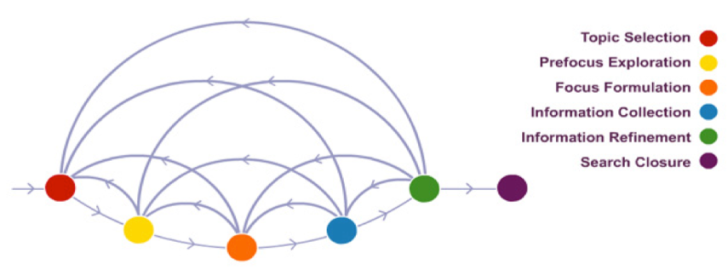A blurry speck in the distance was the beginning of my inquiry-learning journey as mentioned in the initial post, as I was met with uncertainty and vagueness, along with my natural curiosity that sent me seeking for MORE.
As this speck in the distance came into focus I could clearly see what I had had my sights set on during this inquiry process – MORE. I acquired more skills, more knowledge, more awareness, more clarity, more dead-ends, and more light bulb moments. This could go on, but lets leave it at ‘more’. On reflection, I experienced all of the many stages of Carol Kuhlthau’s ISP Model in a variety of combinations.
However, I feel that my progression in the inquiry journey is better represented in the following diagram, due to my random dancing around in some of the stages. The imagery of the WISPR research process model represents the many directional pathways a person can take, and I am certain I did. WISPR is specially designed to introduce students to the scientific research process, with focus on strategies to write a good thesis/research question and ways to effectively find and evaluate information. I would rename each stage in this model to suit the intended audience, but the pale blue lines speak volumes for the distance travelled during the learning processes.
To answer my question about humans ‘trying and testing’, it is clear to see a link to the exploration, formulation and collection stage from the ISP model. During the development of the search strings within the expert searching task, my ‘tried and tested’ knowledge was applied as I attempted to re-use what worked successfully with Google and Google Scholar. When applying it to A+ Education and Proquest Education search engines, my results were unsuccessful. More random dancing around occurred. Whether my presentation and assessment had been displayed as a grand or modest moment, a sense of accomplishment and increased self-awareness occurred in the final stage of posting the newly acquired information about searching online. I also came to realise that each post requirement seemed to feel like a miniature inquiry process as a whole, starting with the initiation and working through to the presentation stage for each new task.
The three areas of interest that appeared clearly into view at the end of this inquiry process were:
- students learning geography as a way of social change
- the development of student research and questioning skills with the assistance of technology
- inquiry learning models designed to support the learning approach
From here, my plans should see active promotion of units that adopt an inquiry learning approach in geography, by way of collaboratively planning with teaching staff, and supporting them with the sourcing, access and training of digital resources. In a teacher-librarian role, many opportunities are available to provide students with learning experiences that develop their skills as researchers, investigators and collaborators, therefore adding to their learning toolboxes for the 21st century. The learner should always be at the centre of the learning, and with the notion of ‘doing inquiry’, students can own their learning experiences and grow from their journey, just as long as they take the first step out of the comfort zone.


